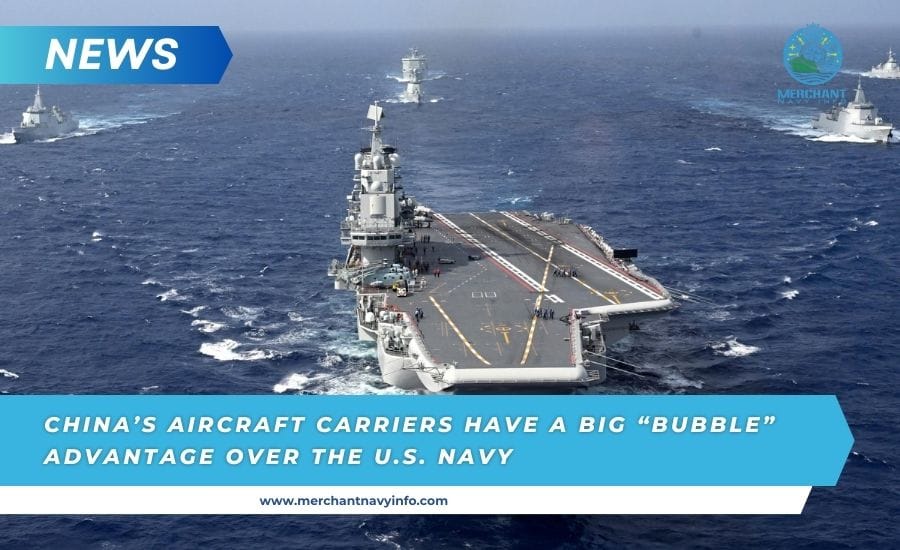
China’s Aircraft Carriers Have a Big “Bubble” Advantage Over the U.S. Navy
The People’s Liberation Army Navy is rapidly expanding its aircraft carrier fleet, with three aircraft carriers already in service and a fourth under construction. Unlike the U.S. Navy, Chinese aircraft carriers do not form the core of its maritime strategy.
What you need to know: The People’s Liberation Army Navy is rapidly expanding its aircraft carrier fleet, with three aircraft carriers already in service and a fourth (sometimes rumored to be nuclear-powered) under construction. Unlike the U.S. Navy, Chinese aircraft carriers do not form the core of its maritime strategy.
Aircraft Carriers
Rather, it operates under China’s anti-access/area denial (A2/AD) system, designed to control the first island chain and suppress U.S. power projection.
These carriers enhance China’s regional influence by operating within the A2/AD bubble, enabling Beijing to control its strategic sphere of influence and deter U.S. military intervention in the Indo-Pacific.
China’s Aircraft Carrier Fleet Grows in A2/AD
The People’s Liberation Army Navy has built an increasingly advanced aircraft carrier fleet. The Russian-built Chinese carrier Liaoning was initially a laughing stock in naval circles, but it has helped the Navy develop into a formidable (albeit untested and still limited) carrier force.
With three carriers in total and a fourth on the way, China’s carrier production is like sausage (thanks to the mass production capabilities that Wall Street handed over to China during the mid-century U.S. deindustrialization boom). Rumor has it that the fourth carrier in China’s growing fleet is nuclear (the other three are non-nuclear).
Wang Yunfei, a retired naval officer with knowledge of Beijing’s carrier plans, said Chinese naval planners want five or six carriers by the 2030s. But that raises the question: How many carriers does China need?
This brings us to the fundamental problem facing most major powers today: the emergence of sophisticated anti-access/area denial systems complicates navies’ ability to project power overseas. At least, that’s the case with the U.S. Navy.
China plans to use carriers within the bubble.
So if ADS severely impedes the ability of the surface fleet to move its assets to long-range target strike ranges – and the Chinese military has been the leader of this revolution – why is Beijing spending so much money and resources developing its own carrier capabilities?
The reason is that despite its horrific human rights record and authoritarian regime, China’s leaders are true military strategists, not politicians.
China they have a multi-step strategy to dominate the Indo-Pacific – starting with the first island chain. There are three island chains, each radiating outward from the previous one. The first island chain stretches from Japan through Taiwan to the Philippines. The second island chain consists of small South Pacific islands stretching from Okinawa, Japan, to U.S.-controlled Guam. The third and final chain consists of the Aleutian Islands in Alaska and stretches to the Hawaiian Islands.
China must eventually control all three chains to dominate the Indo-Pacific. But its priority right now is to control the first island chain. This is, for example, the role of China’s anti-access/area denial constellation throughout the South China Sea. From these forward-deployed positions, China’s A2/AD systems can repel most attempts by U.S. Navy surface warships to get within range of Chinese forces that might be involved in an invasion or even a blockade of Taiwan or any other hostile action against another U.S. ally.
Chinese Aircraft Carriers
Without the ability to reliably confront Chinese forces in the first island chain, Beijing’s military suddenly has strategic freedom within what it considers its sphere of influence.
Essentially, A2/AD systems create a nearly impenetrable “bubble” to protect Chinese forces from U.S. military retaliation. Within the A2/AD protection bubble, Chinese aircraft carriers will operate outside the range of U.S. offensive systems. With the U.S. Navy’s largest power projectors and aircraft carriers in the mix, Chinese aircraft carriers will be free to act and intimidate. That, of course, is the purpose behind China’s powerful A2/AD systems.
Aircraft Carriers Are Not the Focus of China’s Power Projection
Unlike the U.S. Navy, China’s carriers are not the center of gravity of its fleet. These systems help. Curiously, the backbone of China’s offensive maritime strategy is its “no go/deny access” defense systems.
These systems are specifically designed to keep much of the U.S. Navy out, making room for other Chinese naval assets (such as less advanced aircraft carriers) to advance its national interests in the first island chain and keep U.S. power at bay.









